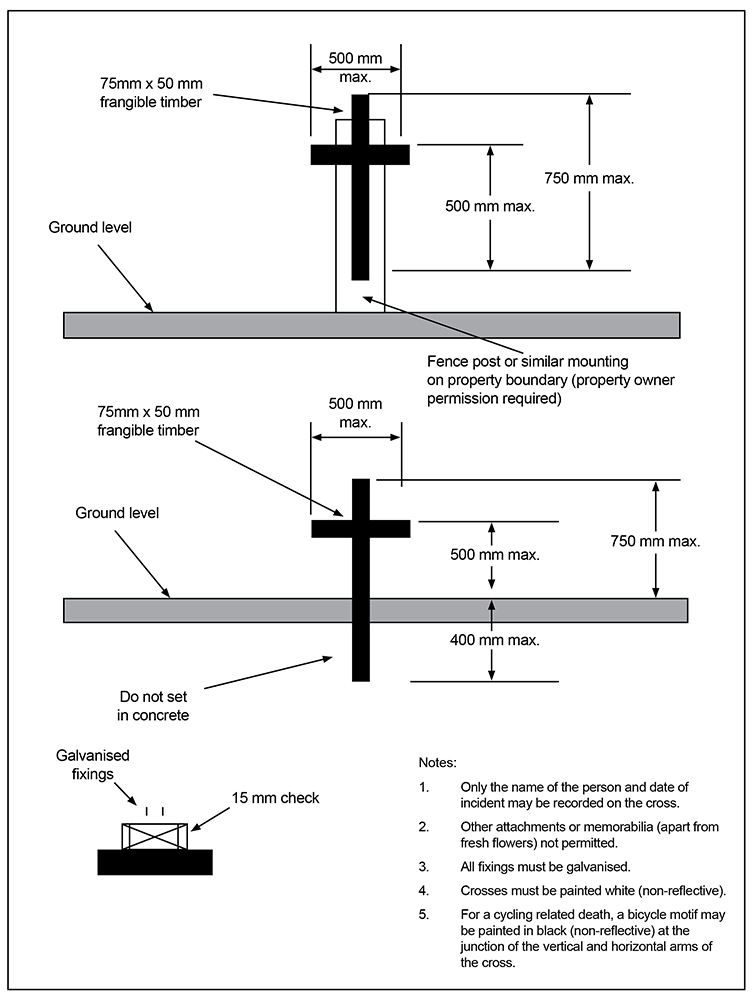Roadside memorials
A roadside memorial is a physical token or object that represents the memory of a person or people who died on or near a road.
When touched by tragedy, family and friends may find that a roadside memorial gives comfort and helps with the grieving process.
These standards relate to installing roadside memorials at a safe location beside state-controlled roads, such as highways and other major roads. Contact your local council about roadside memorials on local roads.
The standards have been designed to present a low safety risk for both visitors to your memorial and for road users. Where these standards are followed it should remove the need to modify or remove your memorial after installation.
When installing roadside memorials, you need to consider:
- road user safety – memorials must not create a safety risk
- local environment – memorials must not contain materials that pollute or damage the environment
- surrounding community – memorials must consider the local community, such as residents in nearby houses.
Please take care when attending a roadside memorial. Ask family and friends to park their vehicles safely and clear of the road.
Tell us about your memorial
You don’t need a permit to install a roadside memorial that complies with these requirements; however, you do need to submit a notification form.
You should also contact your local Department of Transport and Main Roads district office for advice before installing your memorial.
Choosing a roadside memorial
The preferred option for a roadside memorial is a white wooden cross, as it’s less likely to distract motorists and is safer. Please see the drawing at the end of this web page for our standards, that must be followed.
However, you may want a different memorial that suits your customs and values. We will consider these requests, taking into account safety, amenity and community values.
Generally, we discourage roadside memorials close to residential dwellings where they may concern or upset occupants.
You may record a name and date on the memorial, and attach fresh flowers.
Don’t use plastic wrappings or plastic flowers, as mowing may destroy the plastic and damage the environment. Consider native flowers and biodegradable materials.
Other attachments or memorabilia are not permitted, including concrete or non-breakable material.
Contact your local Department of Transport and Main Roads district office if you have questions about memorial types.
Installing and locating a roadside memorial

When installing a roadside memorial, ensure that:
- all road users have a safe environment
- all family, friends and road users are safe while installing and visiting the memorial.
Roadside memorials should be no larger than:
- 750mm high
- 500mm wide
- 400mm deep (below ground level).
The location of a roadside memorial must not interfere with traffic or a road’s operation.
The image above provides you a guide to help install roadside memorials for both on post and in-ground:
First image: roadside memorials attached to post
Fence post or similar mounting should be no larger than 750mm high by 500mm wide.
Second image: roadside memorials in-ground
In-ground roadside memorials should be no larger than 750mm high by 500mm wide. Memorials are to be set 400mm in ground (do not set in concrete).
Notes:
- only the name of the person and date of incident may be recorded on the cross.
- other attachments or memorabilia (apart from fresh flowers) not permitted
- all fixings must be galvanised
- crosses must be painted white (non-reflective)
- for a cycling related death, a bicycle motif may be painted in black (non-reflective) at the junction of the vertical and horizontal arms of the cross.
Memorials are restricted in some locations. For example, memorials are not allowed:
- on motorways and freeways
- on traffic islands
- on medians
- on roundabouts
- within clear zones – these vary according to the road type so please talk with your local Department of Transport and Main Roads district office
- where they may interfere with traffic control devices.
If your chosen location doesn’t meet safety requirements, we can suggest other locations that are safe for drivers and visitors.
It is your responsibility to keep the site tidy and prevent it becoming overgrown.
Insurance
You don’t need indemnity or public liability insurance if you install a roadside memorial that complies with these requirements.
Relocating and removing a memorial
At times, we conduct roadworks and maintenance at the location of roadside memorials.
When roadworks occur, we safely and carefully relocate the memorial to conduct the works and then return it to its original position if possible.
We make every effort to contact the responsible person before removing or relocating a memorial (so make sure you complete the notification form and keep your information up to date).
If a memorial blocks roadworks, becomes a road safety hazard or affects the community and local residents, we may ask the responsible person to remove, relocate or modify the memorial.
If we can’t contact them, we may remove, relocate or modify the memorial.
If a memorial is damaged while being relocated, we will arrange for a replacement that meets the guidelines.
While we remain as careful as possible during mowing and other maintenance activities, we accept no responsibility for damage to roadside memorials during this activity.